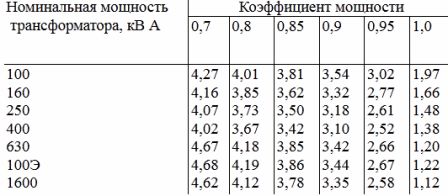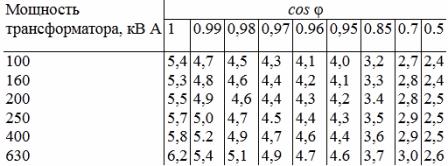Minimum allowable voltage of the receivers
The voltage at the terminals of electric motors under normal conditions should not differ from the nominal by more than 5%.
The voltage drop in the farthest luminaire under normal operating conditions should not exceed 2.5% of the nominal voltage of the lamp.
The voltage loss in the windings of a two-winding transformer is determined by the formulas:


where P is the active load of the transformer MW, Q is the reactive load of the transformer, Mvar; S — full load of the transformer, MBA, U — voltage of the terminals of the transformer, kV, Un — nominal voltage of the network, kV, cosφ — power factor of the load of the transformer, R — active resistance of the transformer windings, Ohm

X — reactivity transformer windings, Ohm

where SN is the rated power of the transformer, MBA, Un.t is the rated voltage of the transformer windings, kV, ΔPK3 is the short-circuit voltage loss in the transformer, MW, Ux is the voltage drop in the transformer reactance,%.
Loss of voltage ΔUltr in transformers 6-10 / 0.4 / 0.23 kV are calculated at nominal load (Table 1).
Table 1. Voltage losses in transformers at nominal load,%.

The total calculated (allowable) voltage loss in the network from the terminals of the transformers to the farthest current collector,%, of the nominal voltage of the receivers is determined by the formulas:
for power networks

for lighting networks

where Uххx is the no-load voltage or the nominal voltage of the secondary winding of the transformer.
The calculated values of voltage losses for power networks ΔUc with a transformer load factor β = 0.9 and the corresponding power factors of the terminals of the secondary winding of the transformer cosφ are given in a table. 2.
The calculated values of available voltage losses for lighting networks ΔUS at transformer load factor β = 0.9 Unom lamps = 220 V and a permissible voltage drop for a lamp of 2.5% of Unom lamps are given in a table. 3.
When determining the voltage deviation in internal networks, voltage losses to the most distant electrical receiver in the amount of up to 2.5% must be taken into account.
Permissible voltage deviations from the nominal voltage of the terminals of electrical receivers,%:
Electric motors — +10 and -5
Lamps for working lighting of industrial enterprises and public buildings, lamps for projector installations for outdoor lighting — +5 and -2.5
The remaining consumers of electricity — +5 and -5
In emergency modes, an additional voltage drop of 5% is allowed.
Table 2. Available voltage losses from the nominal voltage of the receivers,%.

Table 3.Available voltage losses from the nominal voltage of the receivers,%.

